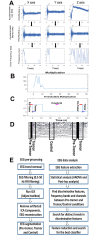Parkinson's disease tremor prediction using EEG data analysis-A preliminary and feasibility study
- PMID: 38001410
- PMCID: PMC10668446
- DOI: 10.1186/s12883-023-03468-0
Parkinson's disease tremor prediction using EEG data analysis-A preliminary and feasibility study
Abstract
Purpose: Tremor is one of the hallmarks of Parkinson's disease (PD) that does not respond effectively to conventional medications. In this regard, as a complementary solution, methods such as deep brain stimulation have been proposed. To apply the intervention with minimal side effects, it is necessary to predict tremor initiation. The purpose of the current study was to propose a novel methodology for predicting resting tremors using analysis of EEG time-series.
Methods: A modified algorithm for tremor onset detection from accelerometer data was proposed. Furthermore, a machine learning methodology for predicting PD hand tremors from EEG time-series was proposed. The most discriminative features extracted from EEG data based on statistical analyses and post-hoc tests were used to train the classifier for distinguishing pre-tremor conditions.
Results: Statistical analyses with post-hoc tests showed that features such as form factor and statistical features were the most discriminative features. Furthermore, limited numbers of EEG channels (F3, F7, P4, CP2, FC6, and C4) and EEG bands (Delta and Gamma) were sufficient for an accurate tremor prediction based on EEG data. Based on the selected feature set, a KNN classifier obtained the best pre-tremor prediction performance with an accuracy of 73.67%.
Conclusion: This feasibility study was the first attempt to show the predicting ability of EEG time-series for PD hand tremor prediction. Considering the limitations of this study, future research with longer data, and different brain dynamics are needed for clinical applications.
Keywords: EEG; Machine learning; Parkinson’s disease; Tremor.
© 2023. The Author(s).
Conflict of interest statement
The authors declare no competing interests.
Figures


Similar articles
-
Vision-based estimation of MDS-UPDRS scores for quantifying Parkinson's disease tremor severity.Med Image Anal. 2023 Apr;85:102754. doi: 10.1016/j.media.2023.102754. Epub 2023 Jan 20. Med Image Anal. 2023. PMID: 36702036
-
Using Machine Learning for Predicting the Best Outcomes With Electrical Muscle Stimulation for Tremors in Parkinson's Disease.Front Aging Neurosci. 2021 Sep 10;13:727654. doi: 10.3389/fnagi.2021.727654. eCollection 2021. Front Aging Neurosci. 2021. PMID: 34566628 Free PMC article.
-
Machine learning aided classification of tremor in multiple sclerosis.EBioMedicine. 2022 Aug;82:104152. doi: 10.1016/j.ebiom.2022.104152. Epub 2022 Jul 11. EBioMedicine. 2022. PMID: 35834887 Free PMC article.
-
[Diagnosis and treatment of tremor in Parkinson's disease and essential tremor].MMW Fortschr Med. 2007 May 21;149 Suppl 2:94-6. MMW Fortschr Med. 2007. PMID: 17724978 Review. German.
-
Clinical neurophysiology of tremor.J Clin Neurophysiol. 1996 Mar;13(2):110-21. doi: 10.1097/00004691-199603000-00002. J Clin Neurophysiol. 1996. PMID: 8849966 Review.
References
-
- Aarsland D, Batzu L, Halliday GM, Geurtsen GJ, Ballard C, Ray Chaudhuri K, et al. Parkinson disease-associated cognitive impairment. Nat Rev Dis Primers. 2021;7(1:47). 10.1038/s41572-021-00280-3. - PubMed
-
- Farashi S. Distinguishing between Parkinson’s Disease patients and healthy individuals using a comprehensive set of time, frequency and time-frequency features extracted from vertical ground reaction force data. Biomed Signal Process Control. 2020;62:102132. doi: 10.1016/j.bspc.2020.102132. - DOI
-
- Grimaldi G, Manto M. Old and emerging therapies of human tremor. Clin Med Insights Ther. 2010;2. 10.4137/CMT.S2999. :CMT.S2999.
MeSH terms
Grants and funding
LinkOut - more resources
Full Text Sources
Medical
Miscellaneous

